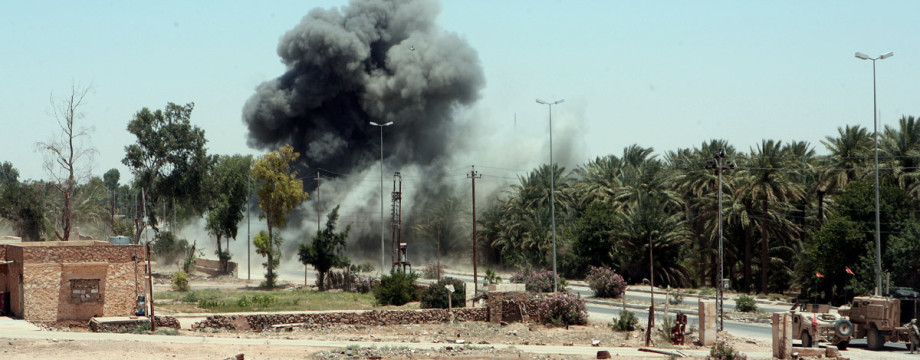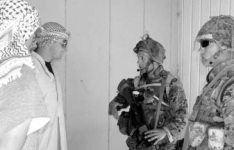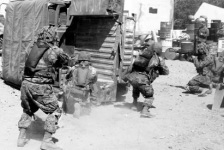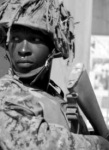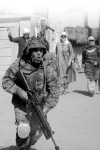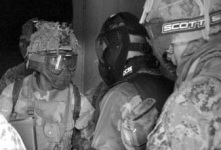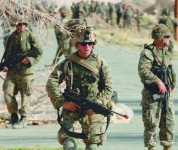 “3/3 Main Body arrived in California to commence PTP in preparation for OEF deployment.” — Source: 3/3 Command Chronology for the Period 01 July to 31 December 2004
“3/3 Main Body arrived in California to commence PTP in preparation for OEF deployment.” — Source: 3/3 Command Chronology for the Period 01 July to 31 December 2004
Contents
3/3 Command Chronology
Marines Air Ground Combat Center
3/3 Main Body arrived in California to commence PTP in preparation for OEF deployment.
MCAS Miramar (NKX)
[Companies] conducted SASO training at the Marine Palms Housing complex in 29 Palms, California, MCAS Miramar, and Segall Studios.
“During Phase I of the PTP at the MCAGCC, each company conducted multiple squad, platoon, and company live fire exercises on the 100 and 400 series ranges. They also used the open training area to conduct specialized live fire training such as the Convoy Assault Course (CAC). The 100 series ranges afforded each company the opportunity to conduct crew served weapons exercises, to include machine-gun and mortar shoots, a night-fire small arms shoot, and a squad level maneuver range. The 400 series ranges (R410, R410A, and R400) allowed for platoon and company reinforced (rein) live fire exercises. The CAC provided Marines necessary live-fire convoy training. Also during Phase I, the Battalion conducted a Fire Support Coordination Exercise (FSCEX), which involved the integration of mortar and artillery fires as well as air support. The FSCEX exposed each FiST to the intricate details of combined arms planning and execution. The 400 series ranges and the CAC were part of the RCAX that was orchestrated and evaluated by the MCAGCC’s Tactical Training Exercise Control Group (TTECG). Leveraging the TTECG’s personnel and expertise enabled the Battalion and Company Staffs to participate in the training without having to focus on conducting the training themselves.”
“Phase II of the PTP focused on Stability and Support Operations (SASO) with special emphasis on entry control points, vehicle checkpoints, urban patrolling, and cordon and search operations. The Battalion conducted Phase II in round robin fashion with three stations and with H&S and Weapons Companies broken down and attached to each of the three line companies so that all received the training. The two venues that supported SASO training were at a 29 Palms condemned housing development (Marine Palms) and Segall Studios, San Diego, California. The Segall Studios training package was divided between the San Diego Studio itself and Camp Elliot, Marine Corps Air Station (MCAS) Miramar, which was just minutes away from the Studio. The use of Segall Studios was necessitated by the turnover of the SASO Training Package at March Air Reserve Base between the 1st Marine Division and TECOM. TECOM could not stand up the instructor and role player support cadre in time to support 3/3. Marines from Third Battalion, Fourth Marines (3/4) insightfully and enthusiastically provided the instructors and role players for the three-day evolution held in Marine Palms development. Marines from 3/4 willingly sacrificed their weekends to share their recent experiences from Operation Iraqi Freedom (OIF) while passing along useful TTPs. The training at Segall Studios, San Diego, was an excellent, realistic training experience. Professional, civilian actors were the role players throughout and provided a sense of realism to the exercise. The elaborate outside village set and indoor “shooting house” also proved beneficial to the training experience. At Camp Elliot, Marines participated in entry and vehicle control points and convoy exercises complete with civilian role players (actors) and special effects pyrotechnics and explosives. The Segall Studios training also exercised the Battalion’s corpsmen with realistic, fully moulaged casualties. The third Phase II training station, held at Camp Wilson, included familiarization classes and practical application sessions on mountain warfare and high altitude operations as well as scenario-based block of instruction on the OEF rules of engagement.” — Source: 3/3 Command Chronology for the Period 01 July to 31 December 2004
Timeline
25-29 August “3/3 Main Body arrived in California to commence PTP in preparation for OEF deployment.”
30 August “3/3 received Marine Corps Air Ground Combat Center (MCAGCC) indoctrination classes from the Tactical Training Exercise Control Group.”
31 August- 10 September [Companies] conducted live fire on Range 101A (Small Arms BZO Range), R103 (squad defensive fire range), R104 (anti-mechanized grenade range), R106 (mortar range), R107 (infantry squad assault range), R108 (infantry squad battle course), R109 (anti-armor live fire tracking range), R110 (MK-19 range), R113 (multi-purpose machine gun range)
31 August-3 September “[Line Companies] conducted platoon live fire on R410A (platoon hasty attack and maneuver range).”
3 September “Battalion FiST Teams participated in Fire Support Classes.”
4-5 September “FiST conducted Fire Support Coordination Exercise in the Quackenbush Training Area.”
4-7 September “[Line Companies] conducted platoon live fire on R400 (company fire and maneuver range).”
6-9 September “[Companies] conducted live fire on the Convoy Assault Course (CAC).”
11-19 September [Companies] conducted SASO training at the Marine Palms Housing complex in 29 Palms, California, MCAS Miramar, and Segall Studios.
Source: 3/3 Command Chronology for the Period 01 July to 31 December 2004
News
3/3 trains for all conditions at CAX
By Lance Cpl. Michelle Dickson | Marine Corps Base Hawaii | September 01, 2004
MARINE CORPS BASE HAWAII, KANEOHE BAY, Hawaii — As preparation for a possible future deployment to Afghanistan, Marines from 3rd Battalion, 3rd Marine Regiment, traveled to Twentynine Palms, Calif., for a Combined Arms Training Exercise during the month of September. During their stay, the Marines from “America’s Battalion” will train using the integration of air and ground elements along with live-fire exercises.
Although the Marines train numerous times every year with similar exercises at the Pohakuloa Training Area on the big island of Hawaii, Twentynine Palms will be more realistic as the weather there is similar to what they could potentially experience in the future, said Cpl. Carlos R. Johnson, operations non-commissioned officer for 3rd Marine Regiment.
“It gets so hot out there during the day,” said Johnson. “It can be 115 degrees during the day, but then drop quickly to freezing temperatures at night. It’s the same way over in the desert.”
Upon finishing their training in Twentynine Palms, the Marines will move on to the Marine Corps Mountain Warfare Training Center, Bridgeport, Calif. This post is one of the most isolated in the Marine Corps and the training emphasizes the development of both individual and unit mountain skills with the primary emphasis on enhancing the overall combat capability of the unit.
“It’s basically the same sort of training that we do when we go to PTA,” said Johnson. “The main thing for the Marines to get used to and be forced to deal with is the harsh weather conditions.” Once training wraps up, Marines will return to MCB Hawaii, Kaneohe Bay, sometime in early October and will await any future deployments.
“The Marines are excited about this opportunity,” said Johnson. “They’ve waited a long time for this chance.”
Source: Hawaii Marine
3/3 hits the sands at Twentynine Palms, the lights of San Diego and the hills of Bridgeport
By Pfc. Rich Mattingly | Marine Corps Base Hawaii | September 14, 2004
CAMP WILSON, TWENTYNINE PALMS, Calif. — As the fiery sun is making its descent over the desert expanses of Southern California, weary warriors trudge back to their hooches, exhausted from another day of some of the most serious training the Corps has to offer.
The Marines may be tired, but they are bold and determined. From across the ranges of the Marine Corps’ infamously grueling Twentynine Palms Air Ground Combat Center, to a mock Middle Eastern village on a movie set in San Diego, the leathernecks of 3rd Battalion, 3rd Marine Regiment, “America’s Battalion,” are midway through a whirlwind pre-deployment package.
Now moving on to the snow-covered hills of the Mountain Warfare Training Center in Bridgeport, Calif., this unique training program was designed to get them prepared, both mentally and physically for an upcoming contingency deployment.
“The purpose of the training exercise is to build ‘strategic corporals,’ to put our Marines in the middle of the three block war and ensure they know how to properly tailor their force so as to protect themselves and their fellow Marines and destroy anti-coalition forces without alienating the local populace,” said 3/3 commanding officer, Lt. Col. Norm Cooling.
America’s Battalion has been moving like a well-oiled machine through live-fire exercises at the platoon and company levels on the grueling ranges at Twentynine Palms. The battalion is also rotating one company at a time through the Strategic Operations training facility located at Segall Studios in San Diego. Here, the Marines will get to experience up close and personal interaction with “locals”, played by Hollywood actors, while on patrol in a town realistically tailored to reflect the “real thing.”
“Strategic Operations is a training facility that prides itself for being different than any other facility,” said Stu Segall, owner of Segall Studios, in a recent interview with the Twentynine Palms base public affairs office. “We use the magic of Hollywood to simulate a real-world training environment for tomorrow’s threat. We combine movie-making techniques with [the experience of desert warfare veterans to create] realism for training needs.”
At the studio, America’s Battalion experienced a mock town complete with costumed “insurgents” and improvised explosive devices.
At an alternate site aboard Marine Corps Air Station, Miramar, the Marines also conducted convoy ops and more Entry Control Point (ECP) and Vehicle Control Point (VCP) training. The Marines conducted these operations while receiving fire from Segall Studio’s professional actors and actresses – some of whom are former service members with combat experience.
“I believe in what we’re doing here. If I could still suit up and be next to them I would,” said Screen Actor’s Guild member and former Navy Seabee Richard Blake, who is currently working for Segall Studios. “We try to make the Marines be as aware of what’s going on around them as we can, trying to put them in situations they may well face over there.”
The realism of the village was astonishing for Marines during their patrol operations.
“It was as close to the fight as I think could be simulated,” said Lance Cpl. Zach Zeid, tactical data network specialist, headquarters and service company, 3/3.
“I had to guard a PUC [person under control] and I had everything we’d trained for running through my head, all of the rules of engagement and everything. I definitely had some adrenaline going through me,” added Zeid.
While the companies were rotating through Segall studios and MCAS Miramar, others were involved in Small Wars training in the abandoned Marine Palms Housing Area aboard Twentynine Palms. There they participated in cordoning and searching, and learned the fine details of vehicle and entry control points with veterans of Operation Iraqi Freedom I and II, Kilo Company, 3rd Battalion, 4th Marine Regiment.
“It’s important to us to try and pass on the things we learned while over there,” said Cpl. Joshua Lipe, squad leader, Kilo Company, 3rd Bn, 4th Marine Regiment.
“We’re teaching them things that we didn’t know before we went, so they can be as prepared for what they will face as possible,” added the Carbondale. Ill. native.
Watching the Marines from Thundering Third with a little extra pride was a 3/3 squad leader, who previously served as a School of Infantry instructor. Many of the Marines from 3/4 were his former students, and they were now training him and his Marines.
“I knew I’d get my chance,” said Sgt. Charles Bennett, a squad leader with 2nd platoon, Kilo Company, 3rd Battalion, 3rd Marines who was serving at SOI during the attacks of September 11. “It makes me feel proud. I’m glad I could do them that service so now they can teach me something. This shows what a brotherhood we are as Marines,” continued Bennett.
The Kilo Company squad leader said his former pupils now had a confidence and fire he hadn’t seen in them before, and that the words and advice on tactics and techniques they passed, couldn’t have come at a better time.
“This training is bringing it all together for us to go out on our deployment and get the job done right,” finished Bennett.
Other Marines have wholeheartedly agreed. And while the days are long and only look to get longer during the pre-deployment package, everyone in America’s Battalion knows that what they learn here will ultimately improve their skills once it’s time to deploy.
From the point men in the fire team, to the highest echelons of command, The Marines of Third Battalion, 3rd Marine Regiment, “America’s Battalion,” are gritty, determined and ready to roll.
Source: Hawaii Marine, 24 September 2004 (Vol 34 No 38)
‘America’s Battalion’ trains to win small wars
By Pfc. Rich Mattingly | Marine Corps Base Hawaii | September 16, 2004
CAMP ELLIOTT, SAN DIEGO, Calif. — The Marines are alert and edgy, their lumbering 7-ton truck bristling with weapons as it winds its way through the dusty convoy course at Camp Elliott. The path is clear for now. Suddenly, the whole sky seems to burn, and the road is obscured in a cloud of dust, debris and the acrid smell of burning sulfur. They’ve been hit.
As 3rd Battalion, Third Marine Regiment continues its high-speed training with special effects support from Segall Studios in San Diego; they are getting a taste of the convoy operations and Security and Support Operations (or “Small Wars”) missions. These are the possible missions they will soon undertake as part of a contingency deployment.
“This training is the culmination of the SASO exercises we’ve been practicing,” said Capt. Skyler Mallicoat, commanding officer, Kilo Company, 3rd Battalion, 3rd Marine Regiment. “The scenario is that we’re going into an Afghani town and supporting voting operation there during an election.”
The mock Afghan town the Marines are operating in and around, is the brainchild of Segall Studio’s production design team and Ken Kirven, construction coordinator.
Ringed by contradictions like aircraft doing touch and go’s at Marine Corps Air Station Miramar and the occasional civilian on horseback, the “town” in question nevertheless looks, smells and feels like a remote village in the Afghan hills.
“We specialize in realism,” said Kirven, “gesturing to the adobe walls, brightly painted with Pashtun and Arabic phrases and signs, and the marketplace filled with bags of grain and trinkets for sale.
No detail is overlooked to provide Marines training here with an experience as close to being there as possible.
Kirven, who is dedicated to making a difference with his construction, was working late into the evening to complete the entire village before the field exercise began. Miraculously, the entire multiple street village was put up by a handful of his men in less than a week.
“We could be working on movies right now, but working with the Marines is far more fulfilling,” said Kirven, as he placed another retaining wall onto a hut. “You can make a movie for a target audience, or you can do something to help out the troops and give them training that will keep them alive.”
And the Marines of America’s Battalion are bent not only on staying alive, but accomplishing the mission at hand. Through the different scenarios, each platoon took different tactical approaches to entering and securing the village and keeping the peace once they were there.
“We’re watching the Marines to see how they interact with the heads of households as well as their individual tactics, techniques and procedures for dealing with the scenarios we throw at them,” said Stewart Brown, observer and controller for 3/3’s training here.
“This is not a pass/fail exercise. This is just another stop along their training and hopefully they can pick up some extra tools,” Brown continued.
According to the “3-block” theory of war fighting, Marines must be ready and capable of handling humanitarian assistance on one block of a city, peacekeeping on the next, and full-on urban fighting on the third.
“We’re trying to slow Marines down a little bit out here,” said Brown, “A lot of them come into this with a ‘third-block’ mentality. The worst thing you can do is go in, be too forceful and find nothing and then have to apologize for your actions. These Marines need to remember that an individual’s actions can send an entire village to the Taliban recruiting office.”
The Marines of 3/3 don’t plan on letting that happen. Instead, they are becoming increasingly confident they know how to properly proportion their use of force for any and all manner of situations they may face. America’s Battalion is ready for anything.
Source: Hawaii Marine
Photographs
- Michael Poliquin
- Jairo Freedonis
